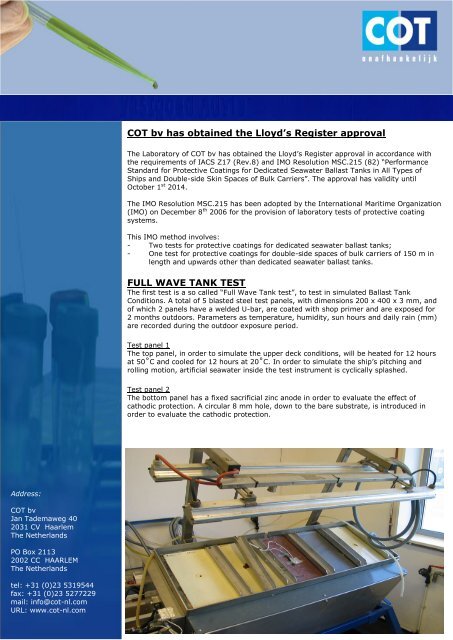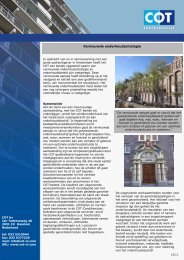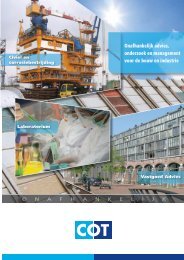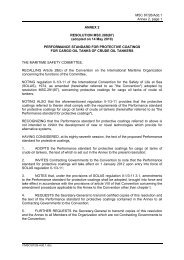Read more - COT.
Read more - COT.
Read more - COT.
You also want an ePaper? Increase the reach of your titles
YUMPU automatically turns print PDFs into web optimized ePapers that Google loves.
Address:<br />
<strong>COT</strong> bv<br />
Jan Tademaweg 40<br />
2031 CV Haarlem<br />
The Netherlands<br />
PO Box 2113<br />
2002 CC HAARLEM<br />
The Netherlands<br />
tel: +31 (0)23 5319544<br />
fax: +31 (0)23 5277229<br />
mail: info@cot-nl.com<br />
URL: www.cot-nl.com<br />
<strong>COT</strong> bv has obtained the Lloyd’s Register approval<br />
The Laboratory of <strong>COT</strong> bv has obtained the Lloyd’s Register approval in accordance with<br />
the requirements of IACS Z17 (Rev.8) and IMO Resolution MSC.215 (82) “Performance<br />
Standard for Protective Coatings for Dedicated Seawater Ballast Tanks in All Types of<br />
Ships and Double-side Skin Spaces of Bulk Carriers”. The approval has validity until<br />
October 1 st 2014.<br />
The IMO Resolution MSC.215 has been adopted by the International Maritime Organization<br />
(IMO) on December 8 th 2006 for the provision of laboratory tests of protective coating<br />
systems.<br />
This IMO method involves:<br />
- Two tests for protective coatings for dedicated seawater ballast tanks;<br />
- One test for protective coatings for double-side spaces of bulk carriers of 150 m in<br />
length and upwards other than dedicated seawater ballast tanks.<br />
FULL WAVE TANK TEST<br />
The first test is a so called “Full Wave Tank test”, to test in simulated Ballast Tank<br />
Conditions. A total of 5 blasted steel test panels, with dimensions 200 x 400 x 3 mm, and<br />
of which 2 panels have a welded U-bar, are coated with shop primer and are exposed for<br />
2 months outdoors. Parameters as temperature, humidity, sun hours and daily rain (mm)<br />
are recorded during the outdoor exposure period.<br />
Test panel 1<br />
The top panel, in order to simulate the upper deck conditions, will be heated for 12 hours<br />
at 50˚C and cooled for 12 hours at 20˚C. In order to simulate the ship’s pitching and<br />
rolling motion, artificial seawater inside the test instrument is cyclically splashed.<br />
Test panel 2<br />
The bottom panel has a fixed sacrificial zinc anode in order to evaluate the effect of<br />
cathodic protection. A circular 8 mm hole, down to the bare substrate, is introduced in<br />
order to evaluate the cathodic protection.
Address:<br />
<strong>COT</strong> bv<br />
Jan Tademaweg 40<br />
2031 CV Haarlem<br />
The Netherlands<br />
PO Box 2113<br />
2002 CC HAARLEM<br />
The Netherlands<br />
tel: +31 (0)23 5319544<br />
fax: +31 (0)23 5277229<br />
mail: info@cot-nl.com<br />
URL: www.cot-nl.com<br />
Test panel 3<br />
This panel is cooled on the reverse side of the test panel in order to give a temperature<br />
gradient of 20˚C to simulate a cooled bulkhead in a ballast wing tank, artificial seawater<br />
inside the test instrument is cyclically splashed.<br />
Test panel 4<br />
This uncontrolled panel is only cyclically splashed with artificial seawater inside the test<br />
instrument.<br />
Test panel 5<br />
The last test panel will be exposed to dry heat at 70˚C.<br />
The Wave Tank test has a duration of 180 days. The temperature of the artificial seawater<br />
will be maintained at 35˚C. Each test cycle consists of two weeks with artificial seawater<br />
and one week empty. The coating system of test panels 1, 3 and 4 are scribed down to<br />
the bare metal.<br />
At the end of the exposure the coated test panels are assessed on blisters and rust,<br />
flexibility, cathodic protection, undercutting from the scribe and adhesion (ISO 4624).<br />
The second test that has to be carried out is the Condensation Chamber test according to<br />
ISO 6270-1, with a test duration of 180 days. The coated test panels, 2 specimen per<br />
coating system, are assessed on blisters and rust and adhesion.<br />
CROSS-OVER TEST<br />
Instead off a Full Wave Tank test, it is also possible to test coating systems on competition<br />
shop primers. In this case a so called “Cross-over” test can be carried out. A Cross-Over<br />
test involves only the Cathodic protection test (like panel 2 in the Full Wave Tank test) but<br />
without the movement.<br />
The coated tests panels in a Cross-Over test are assessed, after 180 days, on blisters and<br />
rust, flexibility, cathodic protection, undercutting from the scribe and adhesion<br />
(ISO 4624).
Address:<br />
<strong>COT</strong> bv<br />
Jan Tademaweg 40<br />
2031 CV Haarlem<br />
The Netherlands<br />
PO Box 2113<br />
2002 CC HAARLEM<br />
The Netherlands<br />
tel: +31 (0)23 5319544<br />
fax: +31 (0)23 5277229<br />
mail: info@cot-nl.com<br />
URL: www.cot-nl.com<br />
If you require the IACS approval for your coating system on (competition) shop primers,<br />
the Laboratory of <strong>COT</strong> bv can carry out the required application assessments, outdoor<br />
exposure (registrations included) and tests.<br />
For any further information regarding this subject you can contact Mr B.P. Alblas<br />
(alblas@cot-nl.com) or Mr M. Walrave (walrave@cot-nl.com), on telephone number<br />
+31 23 531 95 44.





